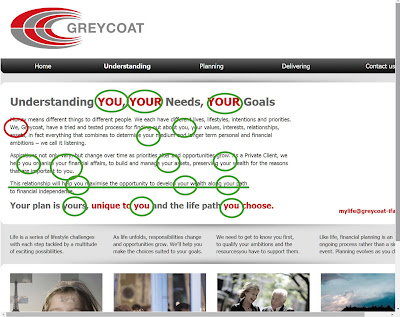Your
pitch - are you a ‘we’ or a ‘you’.
That’s
to say, in your promotional materials – web, brochure, blog, e-mails,
correspondence etc – do you wax lyrical about yourselves, your skills, your
corporate longevity, the latest XY 31/B casting machine you have just installed
and so on.
Or
do you tell your audience, customers, prospects, readers how much they’ll
benefit in terms of their own success, security, value, loyalty by buying the
product or service from you.
[This
as a 'we' copy example - but not quite. This landing page knows it is
'we we'ing' - but in order to emphasise the 'you' as you'll see below.]
There may well be a place and justification for corporate specifications to be stacked up and compared by the reader, but it’s not the headline, front page news you thought it was. You might be excited about your new XY31/B casting machine, but why should I be.
The
lead proposition prospective clients want to know is – have you thought about
us, the client, do you really know what we need? And why we need it? And how,
with it, our lives / businesses will improve?
[Agreed, this is B2C, but there is no reason why B2B should ignore it - your prospects and customers are people too.]
Empathy.
Corporate
websites, particularly B2B, are often overlooked linguistically. The message is
too often ‘we’ ‘we’ ‘we’, set amongst a list of ISOs and professional
associations. Yes, important, but it ‘docks the sale’ not ‘floats the boat’.
Most
towns and cities have a particular street where all the estate Agents,
Solicitors or Building Societies have offices / outlets. The Internet and the
Inbox are the same. Drive past and try to spot the difference. Which do you
choose? What distinguishes one from another?
Well
it’s branding, headline, message.
Your business will enjoy a positive difference and increased inbound activity if you use ASPIRUS Words to review it and your e-mail CRM.












